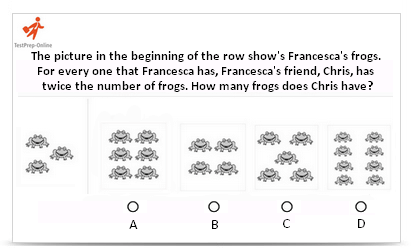There are seven types of OLSAT questions in the Verbal Reasoning category. Learn about the skills needed to master these questions and solve a sample question below. Good luck!
Within the Verbal section of the OLSAT is a subsection called Verbal Reasoning. This section assesses the ability to understand relationships. Specifically, it tests the ability to:
- Find and deduce relationships between words
- Understand and draw conclusions from new situations
- Make comparisons and observe differences or similarities
Verbal Reasoning Question Types
The following table demonstrates the seven Verbal Reasoning question types that appear on the OLSAT Verbal:
| Type | Level | Description |
|---|---|---|
| Aural Reasoning | A-C | These questions test a child’s ability to visualize and understand a situation on both a large and small scale. They focus on the ability to piece together and infer relevant information from smaller details to form an understanding of the bigger picture. Aural Reasoning questions are read aloud by the instructor, additionally testing children’s ability to hear, understand and follow verbal instructions.” |
| Arithmetic Reasoning | A-G | These questions test problem solving abilities. Questions focus more on numerical reasoning and logic than they do on computational abilities. These questions assess the child’s ability to use numbers in order to infer relationships, deduce computational rules, and predict outcomes. |
| Logical Selection | D-G | Logical Selection questions assess the ability to complete sentences and statements about everyday scenarios using simple logic. |
| Word/Letter Matrix | D-G | These questions are similar to fill-in-the-blank type questions and test a child’s ability to fill in the missing piece of the puzzle. Given a matrix of words or letters, a child has to be able to use basic logic to figure out the missing portion of the matrix. |
| Verbal Analogy | D-G | Verbal Analogy questions test the ability to find the relationship between two words, and find a second pair of words that are related in the same way. |
| Verbal Classification | D-G | Verbal Classification questions test the ability to look at a group of words and figure out which one does not belong in the group, based on similarities or differences within the set of words. |
| Inference | E-G | These questions test the ability to infer the correct conclusion given a syllogism. A syllogism is a logical argument based on multiple propositions that are given and assumed to be true. A classic example of a syllogism is as follows: “All men are mortal. Socrates is a man. Therefore, Socrates is mortal.” On the test, children will be given the basic propositions and will have to infer the correct conclusion. |
Verbal Reasoning Sample Question
The following is a sample Arithmetic Reasoning test item from the Verbal Reasoning section.

Answer and Explanation
The correct answer is A.
First, count how many frogs Francesca has. By looking at the picture in the beginning of the row, we see that Francesca owns three frogs. Since Chris has twice the number of frogs, it means he has two times Francesca's three frogs, or 3+3=6 frogs.
How to Prepare for the OLSAT
The OLSAT is an important test which many schools use to assess students' level and determine who will enter their gifted and talented programs. This means your child's results might impact his or her future. The question types seen on the OLSAT are not similar to questions your child encounters at school. Due to these reasons, practicing similar questions before the test is likely to improve your child's score and reflect his or her abilities more accurately.
Build a study plan for your child, covering all question types and leaving extra time for revising types of questions that your child might find more challenging. Involve your child in your planning - this will help ensure he or she follows the plan. Our website offers a full explanation for each question on the practice pack. Encourage your child to try again questions if he or she does not succeed the first time, before reading the explanations. However, it is important to always read the explanations, even if your child answers a question correctly, since the explanation might offer another way to solve the problem which will help in future questions, or extra details your child might not be familiar with.
Make sure your child solves all the questions on the pack. Focusing on types of questions your child finds challenging is crucial. However, even if your child finds certain types of questions easy, it is still highly recommended to solve these questions, as the questions on the actual test come in different levels of difficulty, and obtaining tools for all types of questions will raise your child's chances of success.
OLSAT Question Types
| Verbal | Nonverbal |
|---|---|
| Verbal Comprehension | Pictorial Reasoning |
| Following Directions | Picture Classification |
| Antonyms | Picture Analogies |
| Sentence Completion | Picture Series |
| Sentence Arrangement | Figural Reasoning |
| Verbal Reasoning | Figural Classification |
| Aural Reasoning | Figural Analogies |
| Arithmetic Reasoning | Pattern Matrix |
| Logical Selection | Figural Series |
| Word/Letter Matrix | Quantitative Reasoning |
| Verbal Analogies | Number Series |
| Verbal Classification | Numeric Inference |
| Inference | Number Matrix |



